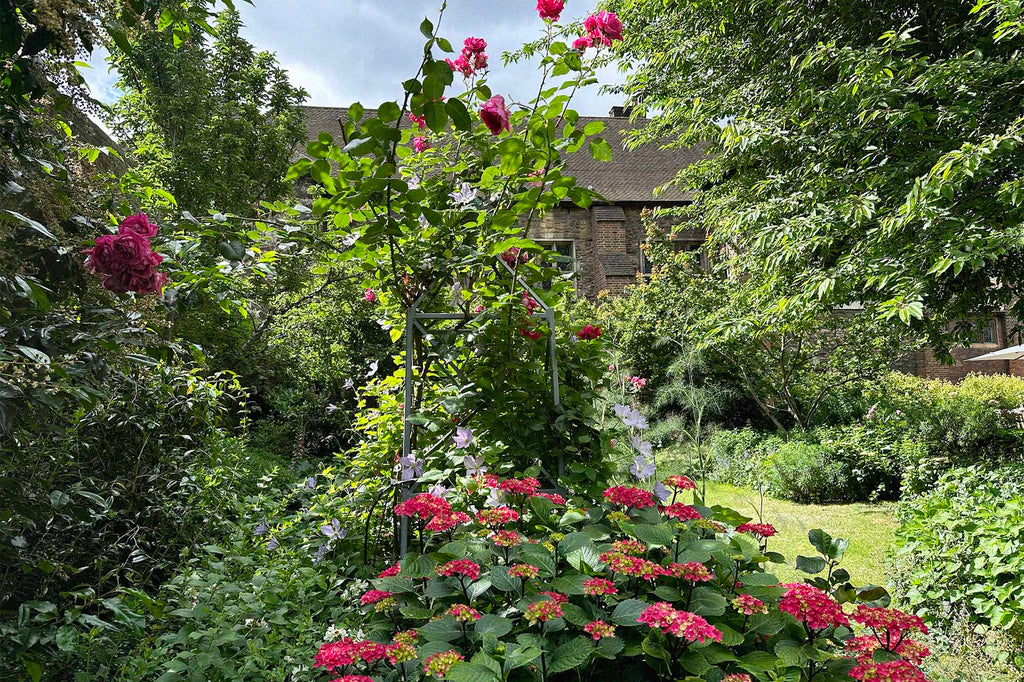London Open Gardens: The Charterhouse, Barbican
Posted by SECRET GARDENER

Walking down the busy streets of the Barbican, it’s hard to imagine there could be a seven-acre secret garden hidden behind the high walls on Clerkenwell Road. Nestled on the edge of the City of London, The Charterhouse is a remarkable site steeped in history, architectural splendour, and verdant beauty.
This hidden gem includes the historic Charterhouse Square, and six enchanting courtyard gardens contained within the ancient Tudor walls of what was once a medieval monastery. These private gardens are meticulously maintained for the benefit of ‘The Brothers’ – residents of the almshouse – and are seldom opened to public view.
Join us as we explore The Charterhouse gardens during London Open Gardens weekend in June, the annual event that opens the gates to over 100 of the city's most remarkable and privately owned green spaces for a weekend.


A Glimpse into The Charterhouse's History
The Charterhouse, originally established in 1371, began its life as a Carthusian monastery built on ground used as a burial pit for victims of the Black Death. Over the centuries, it has served various other purposes: a Tudor mansion visited by royalty, a school (which has since moved to Godalming), and an almshouse. Today, it remains a charitable foundation providing housing and care for its community of retired individuals known as ‘The Brothers’, alongside its historical and cultural offerings.
One of the most significant periods in its history was during the Tudor era. Following the dissolution of the monasteries by Henry VIII, the monks defied the King and were executed for treason. The monastery was seized by the crown, before being purchased by Sir Edward North who converted it into a grand private residence. Later, it was bought by Thomas Sutton, one of England's wealthiest men, who founded the almshouse and school in 1611.

Above: The Charterhouse, London; the Great Hall. Engraving by J. Ow Wellcome, © Wellcome Library
The gardens of The Charterhouse
History remains evident in the architecture of The Charterhouse. The start of the secret garden is accessed from the main building through the Norfolk Cloister, a long, brick corridor with high windows spilling sunlight onto the flagstone floor.


A small door emerges into the garden. The summer has just begun and with it brings flowering pink and red hydrangea, climbing roses, clematis, and foxgloves. It's an otherworldly sight, almost like walking through the cloister has taken us through a time capsule to Tudor buildings and cobbled paths. The only evidence you are still in modern London comes from a glimpse over the wall, where the top of the Barbican estate is just about visible in the distance. Within the dense planting of ferns, hostas, and other perennials, are pockets of lawn with seating for residents, sheltered by trees in dappled sunlight.



Above: one of the old mulberry trees (left) a view of the Barbican above the wall (right)
A series of courtyards unfold as we walk through the garden paths, unveiling a mixture of manicured lawn and re-wilded space. It’s great to see some areas left to grow as they wish, with minimal mowing (small paths have been created within the grass for access).


Above: a path amongst the grass; the wall at the back of the garden meets the busy Clerkenwell Road
We learn that the team of gardeners are increasing biodiversity in the garden – there is an ongoing experiment led by a student at the University of Greenwich, involving strawberry plants. The experiment records the number and variety of pollinators visiting them, with a clever self-watering mechanism and mat to prevent slugs.
The more formal gardens of the cloisters are laid out in squares, with sculptural hedging containing roses, and tall hollyhocks and other fragrant plants in pots lining the edges of the residents’ homes.


Interesting facts about The Charterhouse
The on-site museum, free for the public to visit, offers insights into the past history of the building and its many occupants throughout the years.
Historical residents: The Charterhouse is mentioned in the writings of several notable figures, including Daniel Defoe, Charles Dickens and William Makepeace Thackeray, the latter of which attended the school.
The Black Death: During the Black Death plague in 1348, the land the Charterhouse was built on was used as a burial ground for victims, adding a poignant chapter to its history.
On screen: The Charterhouse's atmospheric setting has made it a popular filming location, featuring in productions such as "Downton Abbey" and "Poirot.”
The gardens of The Charterhouse truly are a very special place. The gardeners have created a tranquil retreat which transports visitors (and residents, I’m sure) to another world, away from the bustle of the streets just a stone’s throw over the wall. It’s a living testament to centuries of heritage, and for garden enthusiasts it offers a unique opportunity to explore beautifully maintained gardens within the context of a site rich in history.


How to get to The Charterhouse
The Charterhouse,
Charterhouse Square,
London EC1M 6AN or EC1M 6AH (Malmaison Hotel – next door to the entrance of the Charterhouse).
Nearest tube: Barbican (Circle, Hammersmith & City, and Metropolitan lines) and Farringdon station (additionally for Thameslink and the Elizabeth Line) is also nearby. Additionally, several bus routes pass close to The Charterhouse, providing further accessibility: buses 4, 56, and 153 stop in front of Barbican station on Aldersgate Street.
Entry: The museum, shop and Chapel are open and free to visit during opening times.
Garden entry: Tours of the garden run on Tuesdays between 1:00pm and 2:00pm. Tickets £18, book online. The Charterhouse also offers their own open gardens event during the summer. For 2024, visitors can enjoy live music, food, and drink on 20 June, 11 July, and the 22 August from 5.30pm-8.30pm. Tickets £10, with concessions available, book online. Visit the website for most up to date information.
Accessibility: The gardens are fully accessible to wheelchair users. Registered disability assistance dogs are welcome in the gardens.
Opening hours: 10:30am to 4:30pm, Tuesday – Saturday.
Head gardener Claire Davies published a book ‘Behind Walls: Enchanting hidden gardens of The Charterhouse’ (2018), where readers can discover both the building’s 650 year history and the plant varieties in its gardens.
***
London Open Gardens is an annual event that opens the gates to over 100 of the city's most remarkable and privately owned green spaces for a weekend, allowing visitors to explore an array of gardens usually hidden from public view.
Organised by the London Parks and Gardens Trust, this event offers a rare opportunity to discover hidden gems tucked away amidst the bustling streets of London. From the historic garden of 10 Downing Street to the contemporary rooftop of 25 Cannon Street, London Open Gardens showcases the rich tapestry of horticultural wonders that thrive within the city. Whether you're drawn to the serenity of a secret garden or the impressive architecture of London’s modern outdoor spaces, this event is a delight for all.

